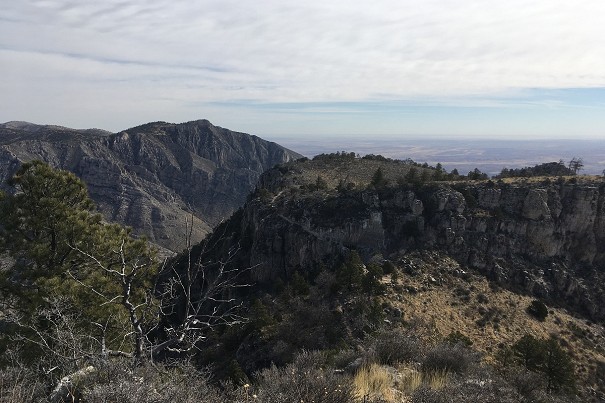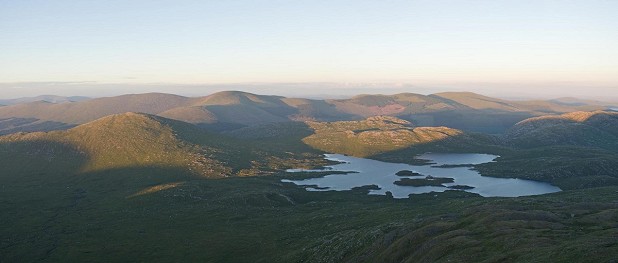
Destination Hillwalking in Wild West Texas
In Spring 2022, Munroist Ian Robertson went to the desert hills of west Texas in search of something a bit different, and ended up having one of the best trips of his 30-year hillwalking career.
Whatever you get from Galloway, it won't be what you were expecting, says Ronald Turnbull, Galloway resident and author of the new Cicerone guidebook to the area.
For some, the surprise is that the Galloways exist at all (and no, they aren't a part of Ireland). In 200 miles of green and rolling Southern Uplands, there's one little patch – it's even smaller than Snowdonia – of unexpected ruggedness, of remote and untamed wild land. It's not the Scottish Highlands, and it's not in any way like the Lake District. Once you've come to terms with the fact that it even exists, it'll still, when you get here, keep hitting you with the unexpected.

Here are nine ways the Galloway Highlands aren't like any other hill range you know:
Who has been the UK's mountain monarch? Bonnie Prince Charlie bagged at least one Munro (he slept out on Sgurr Thuilm) and Queen Victoria is credited with nine. I'd be jolly surprised if our current Queen hasn't followed Great-great-grandma up Lochnagar quite a lot. Despite them all, our King in the Mountains is Robert I of Scotland, commonly known as the Bruce.

As Earl of Annandale he chased the deer across the Galloways. As claimant king in 1306, having been defeated several times (including at Dalrigh on the West Highland Way) he returned to Scotland with 200 hairy-legged swordsmen. It was natural he made Galloway his base of operations.
He looked out over the lowlands from the slopes of Carlin's Cairn, he held 200 armed enemies at bay at the crossing of the Buchan Burn, he fled across the Nick of the Dungeon pursued by his own captured bloodhounds. And finally, in 1307, he achieved his first tiny victory at the Steps of Trool on the side of Mulldonoch. One thing led to another, and seven years later at Bannockburn he sent proud England's Edward homeward, to think again, to think again. Which is what I'm suggesting UKHillwalking readers might like to do about the Galloways.
It's not just human beings who plunge about in the Galloway peatbog, stride knee-deep among the summer tussocks, and scrape our knees on the nasty slabs.
As the saying goes, you don't have to be a goat to go to Galloway – but it certainly helps. While wild goats do hang out in the Cheviots, and on the eastern shore of Loch Lomond, it's in the Galloway Hills that they're uniquely at home.
Somewhat ignored in the present day, the Galloways have been richly appreciated by the Celtic folk who once lived here, the Norse who invaded, and assorted lawless villains of the Middle Ages. When an illiterate horse-thief, speaker of the Gallovidian version of Gaelic, attempts to mispronounce some original Norse, and then gets reinterpreted three centuries later by the Ordnance Survey, the result will be as gnarly and uncompromising as the mountain ground itself. And so we have the Point of the Snibe and the Rig of the Gloon, Loch Macaterick and Loch Neldricken, Mulldonoch and Mullwarchar and the Clints of Dromore.
The so-called Lake District, 60 miles away across the Solway, has eleven lakes. The Galloway Hills have twenty-three. Admittedly just one of them, Loch Doon in the north of the range, is properly equipped with lakeside car parks and a café. By Scottish Highland standards Loch Doon is pretty much a puddle; but if it were in England it'd be England's second largest lake.
A couple of the Galloway's lochs do look to have been kidnapped out of Cumbria. Loch Enoch, a paint-splash of bays and islands ringed by rocky hills, is Eskwater – supposing England's upper Eskdale had the lake it certainly deserves. And if England's most beautiful valley, which is Borrowdale, still had its post-glacial water feature – ringed with oakwoods, reflecting the high crags – well, that would be Loch Trool.
And talking of oakwoods, the 'Wood of Cree', which doesn't entirely exist as yet, will one day be a continuous squirrel-run from the shoreline at Newton Stewart to the top end of Loch Trool.
No Munros – and the four Corbetts (Merrick, Shalloch, Corserine and Cairnsmore of Carsphairn) can all be reached without penetrating the heart of the hills. Yes, Merrick does have a built-up path up to its airy ridgeline called the Nieve of the Spit: it's one of the more enjoyable Corbetts. And there's perceptible paths for the short ways up the other three too.
Those bigger hills form a ring around the edge. In the middle are lower but harsher hills, Mulldonoch and the Dungeon range. And in here it's boulders, and peat, and naked rock. There are some small goat paths, and paths formed by once-every-ten-years visits of the Original Mountain Marathon. Those paths don't go where you're going. But do you really experience mountain ground when you're trailing up a trodden path, behind the dangling pink mug on the purple-turquoise rucksack of the hillwalker in front? It's only once you've got lost, that you get to know where you really are.
Higher mountains are wind-shrivelled moss and stones. The Lake District and Snowdonia are clipped and cropped by sheep. Galloway is shaggy. Midsummer grasses brush against your knees. Between the rock islands, hillsides wave about in moving shades of green.
Late summer grasses, on the other hand, brush against your thighs and hip bones. Up the forest gap on the west side of Meikle Craigtarson, down between the thigh-high tufts and tussocks there are peaty hollows to slip about in. It takes half an hour to cover half a mile, and you emerge with blackened socks and both your walking poles broken.
Some people put chilli pepper in their chocolate. And I can understand this, almost, when I get into Galloway. It's sort of like how Galloway has a whole lot of kneedeep grassland with peaty bits below; but then slips in a granite slab. All the way over Craignaw, or up the ridge of Hoodens Hill, you step out of the clinging grasses onto open rock that's almost like a city pavement. Just supposing city pavements were infested with wild goats and dotted with glacial boulders dropped off by sculptor Henry Moore after an exhibition which didn't sell.
And then, on the slopes of Buchan or Mulldonoch, the granite slabs are angled upwards. Shake the grass seeds out of your socks for a moment of clean, grippy rock that, intriguingly, doesn't have any handholds.
Actually, I still don't get it with the chilli in the chocolate.
Galloway doesn't have its network of scruffy but seductive youth hostels. That cosy pub crouched at the hill foot, brewing its own beer named after Mullwarchar and encouragingly closing the kitchen 10 minutes before you stumble in under your head-torch – well, it isn't there. Okay, the House o' Hill isn't that far down the road. But the Galloway-appropriate nightspot is the bothy. Nowhere, not even the back of Ben Nevis, has such a concentration: five of them, within a single patch of hills.
Because really, all nine surprises are just a single surprise, and that's the granite.
From Cruachan to the Cairngorms, not to mention Yosemite and the High Tatras, granite makes mountains that are different, but never dull. (Okay, maybe Dartmoor is dull.) One granite lump, bubbling usefully upwards as part of the England-Scotland collision, makes the rock-slabs of Craignaw and the bedrock surface below the silver-grey lochans. It lets the devil play at bowls with boulders on the high side of Craignaw. It provides the clints and knowes for Bruce's men to lurk behind. It keeps the goat-hooves clipped and trim; it cups the peaty substrate of the grasslands; it forms the silver beaches of Loch Enoch.
For the ordinary, look elsewhere. For somewhere that's not like where you've already gone, go to Galloway. And no, you won't find it in Ireland.
Guidebook describing mountain walks in the Galloway Hills of southern Scotland, covering Trool, Minnoch, Doon and Talnotry. Offering solitude and rugged natural beauty, this rocky, heathery wilderness presents some great hiking opportunities suitable for experienced hillwalkers. Includes summaries of longer backpack/bothy trips.
Must see: Galloway Forest Park; Merrick, high point of Southern Uplands; 28 tops over 2000ft (600m) with 4 Corbetts (2500ft / 750m); Granite heartland with 31 lochs and lochans; Rivers; ancient oakwood; UK's first dark sky park; guerilla warfare centre of the 14th century...

Comments
Great read up until the author states that Dartmoor is dull. 😤